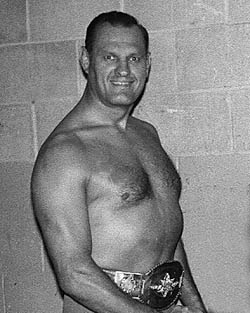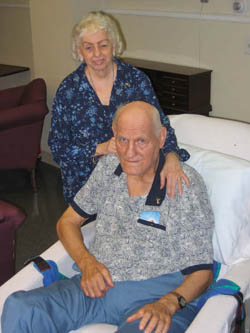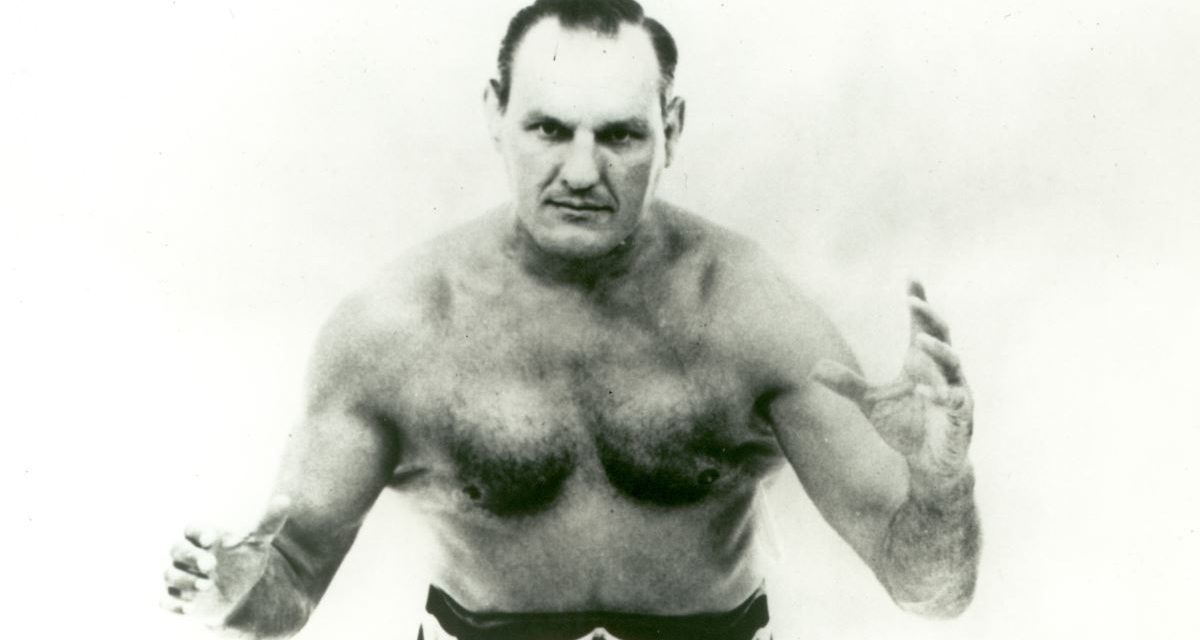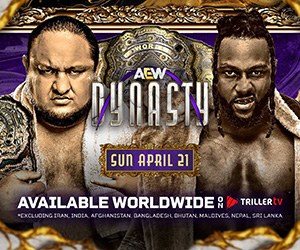The life of Killer Kowalski may have ended on Saturday morning, August 30, 2008, at 12:45 a.m, a few months short of his 82nd birthday, in a Boston area hospital, but his legacy will live on in so many ways. He was one of the most memorable bad guys in history, one of the most articulate and intelligent men in the business, and a trainer of many stars.
As a professional wrestler from 1947 to 1977, few could match Kowalski. He was able to adapt not only to the changing style of wrestling through the years — from the long matches of the 1950s, to the slam-bang shorter matches of the WWWF of the 1970s — but also recover from a car accident that nearly cost him his life, and a personal experiment when he dropped 100 pounds of weight, just to see if he could do it. He also was a vegetarian, sharing his knowledge with a reluctant wrestling world when prompted.

A rare photo of a smiling Killer Kowalski from 1964. Photo by Bob Leonard
When he decided to get off the road, he adapted yet again. Kowalski became a trainer, and developed a friendlier persona for the media who wanted to know more about the well-known school; after all, wrestling schools were few and far between in those days, and Kowalski often claimed to have the first one open to the public. Up until the days of the mass media empire of World Wrestling Entertainment of the late 1990s, few wrestlers had appeared had the visibility of Kowalski — he penned a column for the Boston Herald, he appeared on Late Night With David Letterman (where he memorably quipped, “No no, that’s loved” not loathed), he was featured in People Magazine and Maclean’s.
As he aged, Kowalski seemed to mellow, even marrying for the first time at 79 years old. He became an elder, beloved statesman, profiled by Esquire magazine when he was 80 in a column titled “What I’ve Learned.” His peers recognized him with the industry’s top honour, the Iron Mike Mazurki Award, presented by the Cauliflower Alley Club at its 2002 reunion in Las Vegas. Kowalski was also a member of the Professional Wrestling Hall of Fame (2003), The Wrestling Observer Hall of Fame (1996) and the WWE Hall of Fame (1996). The National Polish-American Sports Hall of Fame in Troy, Michigan recognized him as well in 2007.
Don Leo Jonathan considered Kowalski a good friend, yet didn’t know his real name, or much about his family.
“Wally was sort of an individual. He certainly didn’t go along with a lot of the stuff that the guys did,” said Jonathan. “He was, I don’t want to say a loner, because he could be quite charming and he got along good with everybody, but if you done something that he really didn’t like, he would let you know about it — especially if it would hurt the business. He was very conscientious about wrestling.”
In his book, I Was a Teenage Professional Wrestler, wrestler-turned-artist Ted Lewin tried to explain Kowalski’s dualness. “Kowalski, the meanest, kindest human being you’d ever want to meet. He was as gaunt and lean as a Southern preacher, and a strict vegetarian. It was a wonder how he maintained his weight of two hundred and eighty pounds on lettuce and carrots.”
Growing up in Windsor, Ontario, Edward Walter Spulnik — his birth name — was a tall, skinny kid, weighing 160 pounds on a 6-foot-4 frame at age 14. He found his way to the local YMCA, where others convinced him that weightlifting would easily add pounds to his frame. It worked, and he grew into a 6-foot-7, 270-pound man.
Kowalski enrolled at Assumption College (now part of the University of Windsor), studying electrical engineering, and found part-time work with the Ford Motor Company in Detroit.
While at the YMCA, someone suggested that professional wrestling was a good career for him. Kowalski hooked up with Detroit promoter Burt Ruby, who saw something in the giant. Over the years Kowalski claimed his first match was against Lou (Klein) Bastien, in 1948.
St. Louis promoter Sam Muchnick saw something in “Tarzan” Kowalski, and matched him up against world champion Lou Thesz. A conflict with getting time off from Ford to wrestle abroad let to Kowalski quitting his “day job.”
In those early years, known as Tarzan Kowalski, he fought to get better known. “He was a hell of an attraction,” said Lou Thesz in 1998. “He had a great body back then. He was not a sophisticated wrestler, but every promoter wanted him because he made a lot of money.”
“Killer Kowalski — when I first saw him I thought he was the most magnificent specimen of a human being I’d ever seen in my life,” Joe Hamilton told Rich Tate of Georgia Wrestling History. “He was working out at the gym and was six feet six and about 280 pounds, and he was ripped and just looked phenomenal. You know, back then they called him Tarzan Kowalski, and he looked like Tarzan should look like — big and powerful.
Incredibly famous as a bad guy wrestler, few fans realize that he was a popular fan favorite for many years. “Kowalski, who has made quite a sweep of rivals and has become popular with the fans,” reads one write-up. Kowalski always maintained that he turned fully heel simply because fans started booing him.
“He was such a good looking guy. He 6-foot-8, weighed over 300 pounds, and had long hair and looked like Tarzan. He looked real good at whatever he did,” said Paul “Butcher” Vachon. “The women just loved him and the men hated him. I heard about women fainting when Killer Kowalski came into the ring.”
“Just because I get over-enthused about my work people hate me,” Kowalski said in a 1961 article in Wrestling Revue. “Everywhere I go they throw chairs, newspapers, cigar butts, fruit and anything else they can grab. I have been burned, knifed, blinded by pea shooters and hit over the head with boards.”
Though never recognized as one of the “big three” world champions (AWA, WWWF, NWA), Kowalski held claim to the world title out of Australia six times from 1964-67 and a variant of the AWA World title based out of Boston. He also held a plethora of other belts: NWA Texas tag team (by himsef!) in 1950, the Central States champ in 1951, the Pacific Coast tag team champ in California in 1951, the International champion in Quebec a remarkable 11 times from 1952-63, the Big Time Wrestling champ 1958-61, the Pacific Coast tag team champ in B.C. twice in 1961-62, the Stampede Canadian champ in 1962, the WWWF U.S. tag team titles in 1963, the Hawaiian U.S. Heavyweight belt in 1965-66, the IWA tag team belts in Australia four times from 1967-71, the NWA America’s title in 1972, the Grand Prix heavyweight and tag team titles out of Montreal two times each from 1972-73, the NWA Southern title in Florida in 1975, and the WWWF tag team belts in 1976 (under a mask as the Executioners with John Minton, a.k.a. Big John Studd).
Retired from the ring since 1977, Kowalski has been a trainer of wrestlers for years. His biggest name students are Triple H, Big John Studd, Chyna, Mike Shaw (Makhan Singh, Norman the Lunatic, Bastion Booger) and Frankie Kazarian.
“Kowalski had a great school. He spent a lot of time with us,” said Shaw.

Theresa and Walter Kowalski at the beginning of August. Photo by Jason Clevett
“Anyone who knows me knows that I have always attributed Walter with all of my success in pro wrestling,” wrote Kazarian on his blog after Kowalski’s passing. “He took in a 20 year old kid who had traveled 3,000 miles from southern California, and embraced him like a son. He was kind enough to pass on his extensive, and unique knowledge of this business to me. From day one, Walter became my trainer, and my friend. He guided me through every step of pro wrestling, but more importantly, taught me how to be a genuine, good person, and to treat others with respect, dignity and class. I owe so much to Walter, that I could never put it all in words. The time we spent together is and always will be some of the most precious memories I have, and I will keep it in a special place in my heart.”
The way Kowalski tells the story, he didn’t want to be a trainer. “They kept talking to me. I had nothing to do anyway, sitting home watching TV. So I started training guys at the Salem YMCA,” he said in 1998. “That was the first wrestling school of all in 1978. So I start training guys and pretty soon they start writing it up. I was on the David Letterman show. And before David Letterman, I was on other TV shows. Word got out, there’s a wrestling school. Killer Kowalski. We had guys come all the way from California. A whole TV crew came to show me working out, wrestling, working out the guys. I got a lot of publicity that way too. I just kept at it. Now I can’t get out of it!”
For many years, Kowalski ran a promotion in the Northeast U.S. that had television. It was a chance for youngsters to hone their craft, and some old friends to continue working.
Kowalski had been confined to a nursing home for a few months, with problems with his knees. Doctors were reluctant to operate on an 81-year-old former wrestler who had a pacemaker. On Friday, August 8th, Kowalski suffered a heart attack and was moved to a hospital. For the rest of the month, the prognosis for a recovery rarely looked good. The family — Kowalski’s wife Theresa, and brother Stanley — decided to remove him from life support. The incredible physical specimen that he was, Kowalski lasted more than a week with a supply of oxygen and his functioning pacemaker. The family welcomes remembrances of Kowalski at his nephew’s blog: walterkowalski.blogspot.com/.
Though he never released an autobiography, Kowalski did publish a book of his photography in 2001, entitled Killer Pics.
Walter Kowalski — his legal name since 1963 — is survived by his wife Theresa, brother Stanley and sister-in-law Colette, of Ottawa, nephews Jan, Anthony, and Mark, and niece Laura. He is predeceased by his sister Wanda, and parents, Mary and Anthony.
The funeral will be on Wednesday at Weir Funeral Home, 144 Salem St., Malden, MA 02148. Afternoon services are at 2 p.m. and evening services at 6 p.m.
A fund to pay for Kowalski’s medical care has been set up that is accessible ONLY by Theresa Kowalski. The address to directly send funds that will be immediately available to help with medical costs and other expenses is: The Walter “Killer” Kowalski Memorial Fund; Citizens Bank; 876 Main St.; Malden, MA 02148. A benefit show to raise funds is in the works as well for Malden, on Sunday, October 26 at 2 p.m.
RELATED LINK
Greg Oliver first met Killer Kowalski in 1998. One of his favourite memories following the publication of The Pro Wrestling Hall of Fame: The Canadians was a message from Kowalski (#3 Canadian all-time), saying, “Greg, thanks for putting me over.”



